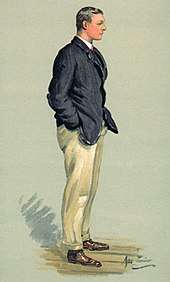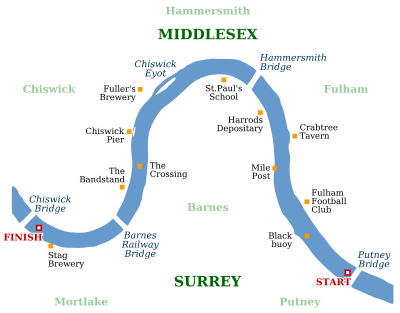The Boat Race 1935
The 87th Boat Race took place on 6 April 1935. Held annually, the Boat Race is a side-by-side rowing race between crews from the Universities of Oxford and Cambridge along the River Thames. Umpired by former Oxford rower Robert Bourne, Cambridge won by four and a half lengths in a time of 19 minutes 48 seconds. The record twelfth consecutive victory took the overall record in the event to 46–40 in Cambridge's favour.
| 87th Boat Race | |||
|---|---|---|---|
| Date | 6 April 1935 | ||
| Winner | Cambridge | ||
| Margin of victory | 4 1/2 lengths | ||
| Winning time | 19 minutes 48 seconds | ||
| Overall record (Cambridge–Oxford) | 46–40 | ||
| Umpire | Robert Bourne (Oxford) | ||
| Other races | |||
| Women's winner | Oxford | ||
| |||
Background

The Boat Race is a side-by-side rowing competition between the University of Oxford (sometimes referred to as the "Dark Blues")[1] and the University of Cambridge (sometimes referred to as the "Light Blues").[1] The race was first held in 1829, and since 1845 has taken place on the 4.2-mile (6.8 km) Championship Course on the River Thames in southwest London.[2][3] The rivalry is a major point of honour between the two universities; it is followed throughout the United Kingdom and, as of 2014, broadcast worldwide.[4] Cambridge went into the race as reigning champions, having won the 1934 race by four and a quarter lengths, and led overall with 45 victories to Oxford's 40 (excluding the "dead heat" of 1877).[5][6]
Cambridge's coaches were D. H. E. McCowen (who had rowed in the 1932 race) and, according to the rowing correspondent for The Times, "two eminent Metropolitan coaches" in R. A. Nisbet and C. H. Rew.[7][8] Oxford were coached by Francis Escombe and Peter Haig-Thomas, both of whom previously coached the Light Blues, and former Light Blue rower Kenneth Payne (who rowed for Cambridge in the 1932 and 1934 races).[8] The race was umpired by former Oxford rower and boat club president Robert Bourne who had stroked the Dark Blues to four consecutive victories between 1909 and 1912, while the finishing judge was C. W. Kent.[9] Both boats were made by Sims and both crews used Ayling's oars.[10]
The rowing correspondent for The Times noted that "neither crew is exceptionally fast" and suggested that Oxford's heavier crew would out-perform Cambridge, who he claimed "will be seen at their best in calm conditions".[10] As a result of Oxford's practice rows during the period running up to the race, former Dark Blue rower E. P. Evans, writing in The Manchester Guardian, stated "Cambridge are now at the zenith of their power and are not likely to improve, whilst Oxford are still in the stages of reaching perfection".[11]
Crews
The Oxford crew weighed an average of 12 st 13 lb (81.9 kg), 4.375 pounds (2.0 kg) per rower more than their opponents. Cambridge saw four participants with Boat Race experience return to the crew, including cox Noel Duckworth. The Light Blue crew also included a pair of brothers in Annesely and Desmond Kingsford. Oxford's crew also contained four former Blues, including P. R. S. Bankes and John Couchman, both of whom were rowing in their third consecutive race.[12] All of the race participants were registered as British.[13]
| Seat | Cambridge |
Oxford | ||||
|---|---|---|---|---|---|---|
| Name | College | Weight | Name | College | Weight | |
| Bow | T. R. M. Bristow | Pembroke | 12 st 4 lb | R. Hope | New College | 12 st 2 lb |
| 2 | E. A. Szilagyi | Jesus | 12 st 3 lb | D. M. de R. Winser | Corpus Christi | 11 st 9.5 lb |
| 3 | A. D. Kingsford | Pembroke | 12 st 4 lb | E. E. D. Tomlin | University | 12 st 5 lb |
| 4 | J. H. C. Powell | 3rd Trinity | 12 st 0 lb | P. R. S. Bankes | Christ Church | 14 st 3 lb |
| 5 | D. G. Kingsford | Pembroke | 12 st 0 lb | D. R. B. Mynors | New College | 13 st 0 lb |
| 6 | M. P. Lonnon | 3rd Trinity | 12 st 8 lb | J. M. Couchman | Christ Church | 12 st 13.5 lb |
| 7 | J. H. T. Wilson | Pembroke | 12 st 13 lb | B. J. Sciortino | University | 12 st 10 lb |
| Stroke | W. G. R. M. Laurie | Selwyn | 13 st 7 lb | A. V. Suitcliffe | Trinity | 14 st 5 lb |
| Cox | J. N. Duckworth | Jesus | 7 st 13 lb | C. G. F. Bryan | Worcester | 7 st 13 lb |
| Source:[12] (P) – boat club president[14] | ||||||
Race

Cambridge won the toss and elected to start from the Surrey station, handing the Middlesex side of the river to Oxford.[12] The umpire Bourne started the race at 2:48 p.m. in strong and gusty wind, and rough water.[15] The Light Blues made the quicker start, out-rating Oxford by three strokes within the first minute, and led by half a length. Thirty seconds later, Cambridge were clear and were further ahead by Craven Steps. By the end of the Fulham Wall, Duckworth steered directly towards the Surrey shore in an attempt to find shelter from the conditions.[15] A spurt from the Dark Blues made no difference to the gap and Cambridge passed the Mile Post almost two lengths ahead.[16] Another spurt from Oxford at Harrods Furniture Depository once again made no impact on the deficit and Cambridge passed below Hammersmith Bridge with a lead of three lengths.[15]
Intelligent steering from C. G. F. Bryan, the Oxford cox, saw the Dark Blues "hugging the Surrey bank" to reduce the Cambridge lead to about a length by Chiswick Eyot. It was short-lived however, as Bryan steered back over towards the Middlesex side of the river, losing his crew a length in doing so and moving into rougher water, and by Chiswick Steps, the Light Blues were four and a half lengths ahead. Cambridge's stroke Ran Laurie called for a spurt and by the time they passed under Barnes Bridge they were five lengths ahead. They crossed to the Middlesex side of the river before passing the finishing post with a lead of four and a half lengths in a time of 19 minutes 48 seconds.[12][16] It was a record twelfth victory for the Light Blues and took the overall record in the event to 46–40 in their favour.[5] Former Oxford rower E. P. Evans, writing in The Manchester Guardian, stated that Cambridge "won in the easiest manner possible, having led from start to finish" and described the race as a "fiasco".[15] The rowing correspondent for The Times suggested that "never was it so obvious after the first few strokes that there was only one crew in the race ... Oxford's form was too bad to be true."[16]
References
Notes
- "Dark Blues aim to punch above their weight". The Observer. 6 April 2003. Retrieved 20 August 2014.
- Smith, Oliver (25 March 2014). "University Boat Race 2014: spectators' guide". The Daily Telegraph. Retrieved 20 June 2014.
- "The Course". The Boat Race Company Limited. Retrieved 24 July 2014.
- "Former Winnipegger in winning Oxford–Cambridge Boat Race crew". CBC News. 6 April 2014. Retrieved 20 August 2014.
- "Boat Race – Results". The Boat Race Company Limited. Retrieved 25 August 2014.
- "Classic moments – the 1877 dead heat". The Boat Race Company Limited. Archived from the original on 28 October 2014. Retrieved 20 August 2014.
- Burnell, pp. 110–111
- "Boat Race day – Oxford's heavy crew". The Times (47032). 6 April 1935. p. 13.
- Burnell, p. 49
- "Boat Race Day". The Times (47032). 6 April 1935. p. 13.
- Evans, E. P. (2 April 1935). "Boat-race practice ending". The Manchester Guardian. p. 4.
- Dodd, p. 329
- Burnell, p. 39
- Burnell, pp. 50, 52
- Evans, E. P. (8 April 1935). "Cambridge's easy victory". The Manchester Guardian. p. 4.
- "Cambridge win again". The Times (47033). 8 April 1935. p. 5.
Bibliography
- Burnell, Richard (1979). One Hundred and Fifty Years of the Oxford and Cambridge Boat Race. Precision Press. ISBN 0950063878.
- Dodd, Christopher (1983). The Oxford & Cambridge Boat Race. Stanley Paul. ISBN 0091513405.

